
The Ultimate Guide to Buying a Sauna: Health Benefits & What to Consider
This guide to buying a sauna is a part of our Intentional Shopping series focused on helping our readers make more thoughtful and quality purchases.
Saunas, long revered for their relaxing and rejuvenating effects, have been a part of human culture for centuries. Originating in Finland, saunas have transcended cultural boundaries and are now enjoyed worldwide. While the ritual of sitting in a sauna might seem like a simple pastime, scientific research has unveiled a treasure trove of health benefits associated with this age-old practice.
Wondering what to consider when buying a sauna?
In this comprehensive guide, we delve into the diverse benefits of saunas, the different types available, and what to consider when buying a sauna to ensure you buy the best sauna to fit your needs.
Sauna Shopping Guide
(Quick Links)
Sauna Buying Guide
The Healing Power of Saunas

Stress Reduction and Improved Mental Health
One of the primary benefits of regular sauna use is stress reduction and enhanced mental well-being. A study published in the “Journal of Alternative and Complementary Medicine” found that sauna bathing significantly decreased levels of the stress hormone cortisol in participants, leading to reduced perceived stress and increased feelings of relaxation and tranquility. Saunas provide a sanctuary for both the body and mind, allowing individuals to disconnect from the outside world and find solace in the soothing heat.
Detoxification and Improved Skin Health
Sweating is the body’s natural mechanism for eliminating toxins, and saunas amplify this process. As you sweat in a sauna, your pores open, and impurities are expelled from your skin. A study published in the “Archives of Environmental Contamination and Toxicology” discovered that saunas help eliminate a range of harmful substances, including heavy metals and environmental chemicals, from the body. The result is not only improved detoxification but also healthier, clearer skin.
Cardiovascular Health
Regular sauna sessions have been linked to a reduced risk of cardiovascular diseases. A study conducted in Finland, where saunas are an integral part of the culture, revealed that frequent sauna use is associated with a lower risk of heart disease, stroke, and all-cause mortality[^3^]. Sauna-induced heat leads to the dilation of blood vessels, reducing blood pressure and improving overall cardiovascular function. This effect mirrors the benefits of exercise, making saunas an excellent addition to a heart-healthy lifestyle.
Muscle and Joint Pain Relief
The heat and steam in saunas can provide profound relief for muscle and joint pain. The increased blood flow and circulation stimulated by sauna sessions can alleviate discomfort and promote healing. A study published in the “Annals of Clinical Research” highlighted the positive impact of sauna therapy on patients with chronic pain conditions, including fibromyalgia and rheumatoid arthritis[^4^]. Regular sauna use may be a valuable complementary therapy for individuals suffering from chronic pain.
Weight Loss and Calorie Burn
A sauna session will not only reduce water weight, but it can also potentially increase caloric burn. In a 2019 research study centered on sedentary and overweight individuals assigned male at birth, it was discovered that undergoing four 10-minute sauna sessions led to notable alterations in various physiological indicators. These changes encompassed modifications in heart rate, energy expenditure, body mass index (BMI), and body surface area.
The study’s findings revealed that participants experienced a reduction of approximately 0.65 kilograms (kg) in body fluids as a result of the sauna sessions. Moreover, it was observed that individuals with greater body mass, body area, body fat content, and muscle mass exhibited comparatively higher calorie expenditure during their sauna bathing sessions.
Types of Saunas

Traditional Finnish Saunas
The traditional Finnish sauna, often called a dry sauna, is characterized by its high temperature and low humidity. These saunas typically use wood-burning or electric heaters to produce dry heat, with temperatures ranging from 160°F to 195°F (71°C to 90°C). Bathers in Finnish saunas enjoy the benefits of increased blood circulation, detoxification through sweat, and deep relaxation.
- Heat Source: Finnish saunas can be heated using either wood-burning stoves or electric heaters with sauna rocks.
- Temperature: These saunas typically reach high temperatures, ranging from 160°F to 195°F (71°C to 90°C).
- Humidity: Finnish saunas are known for low humidity levels, making the heat feel intense and dry.
- Benefits: They provide deep relaxation, detoxification through sweat, and improved circulation.
Infrared Saunas
Infrared saunas use infrared heaters to emit radiant heat that penetrates the body’s tissues directly, heating the body from the inside out. These saunas operate at lower temperatures (around 120°F to 140°F or 49°C to 60°C) but still induce profuse sweating. Infrared saunas are favored for their gentle heat and potential health benefits, such as improved circulation, pain relief, and detoxification.
- Heat Source: Infrared saunas use infrared panels to emit radiant heat.
- Temperature: Operating at lower temperatures (around 120°F to 140°F or 49°C to 60°C), they are gentler than traditional saunas.
- Health Benefits: Infrared saunas are known for pain relief, improved circulation, and detoxification.
- Energy Efficiency: They tend to be more energy-efficient than traditional saunas.
Steam Saunas
Steam saunas, often referred to as steam rooms, create a humid environment by generating steam. The temperature in steam saunas typically ranges from 110°F to 115°F (43°C to 46°C). These saunas are celebrated for their skin benefits, as the moist heat can hydrate and rejuvenate the skin. Additionally, the inhalation of steam can be soothing for respiratory conditions.
- Heat Source: Steam saunas use a steam generator to produce steam.
- Temperature: They typically operate at temperatures of 110°F to 115°F (43°C to 46°C).
- Humidity: High humidity levels make them a soothing option for respiratory health and skin benefits.
- Installation: They require proper ventilation and waterproofing due to the moisture involved.
What to Consider When Buying a Sauna
When considering the purchase of a sauna for your home, several factors warrant careful consideration. Below we dive into the top factors to consider when buying a sauna so you can purchase the best sauna for your needs.
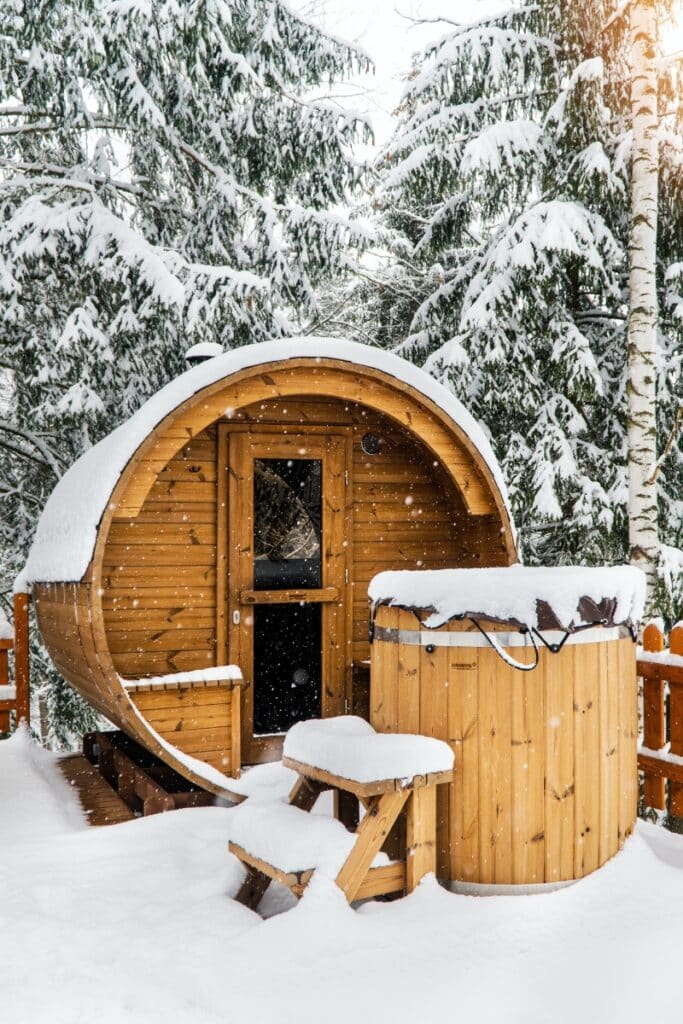
1. Size and Capacity
Determine how many people will be using the sauna at once. Saunas come in various sizes, from compact 1-person units to spacious 6-person options. Ensure your sauna comfortably accommodates the number of users you anticipate. Remember that a larger sauna may require more space in your home or backyard.
What to consider:
- 1-Person Sauna: Ideal for smaller spaces and energy efficiency.
- 2-Person Sauna: Ideal for couples and vacation homes.
- 3-6 Person Sauna: Ideal for larger spaces, families, or homes with frequent guests.
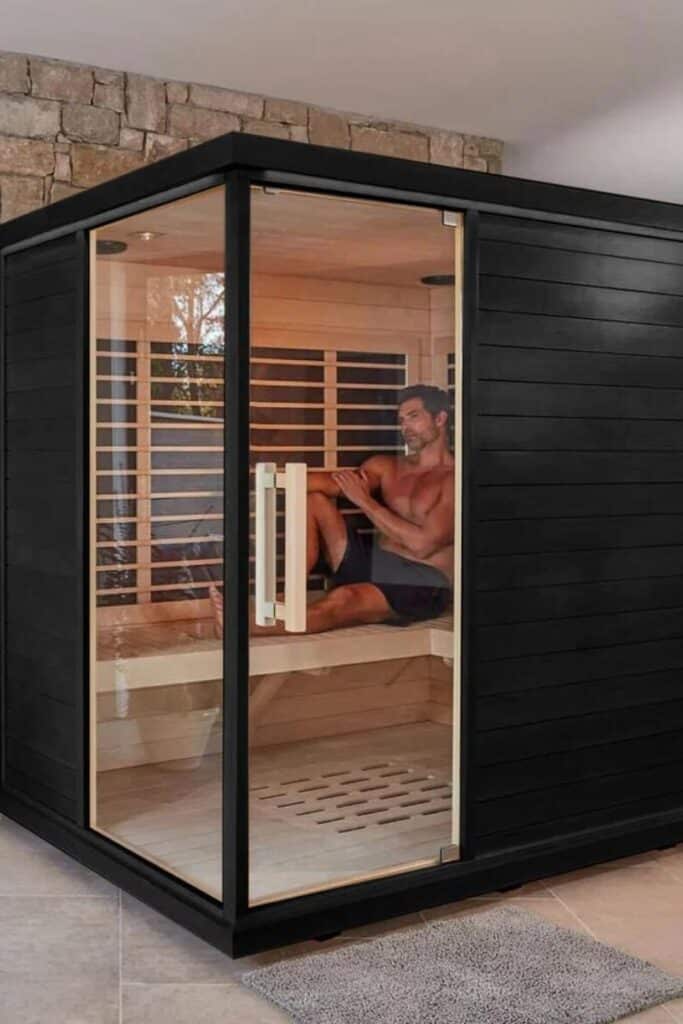
2. Type of Sauna
Choose the type of sauna that suits your preferences and health goals. Whether it’s a traditional Finnish sauna, an infrared sauna, or a steam sauna, each has unique benefits.
What to Consider:
- Finnish Sauna: Provides a classic sauna experience with intense heat and the option to create bursts of steam by adding water to the hot rocks. May consume more energy than infrared saunas due to the higher temperatures required to operate.
- Infrared Sauna: Provides a milder, less intense sauna experience with less emphasis on steam.Tends to be more energy-efficient than traditional saunas due to lower operating temperatures.
- Steam Sauna: Provides a humid environment by generating steam which is good for respiratory health and moisturizes the skin.
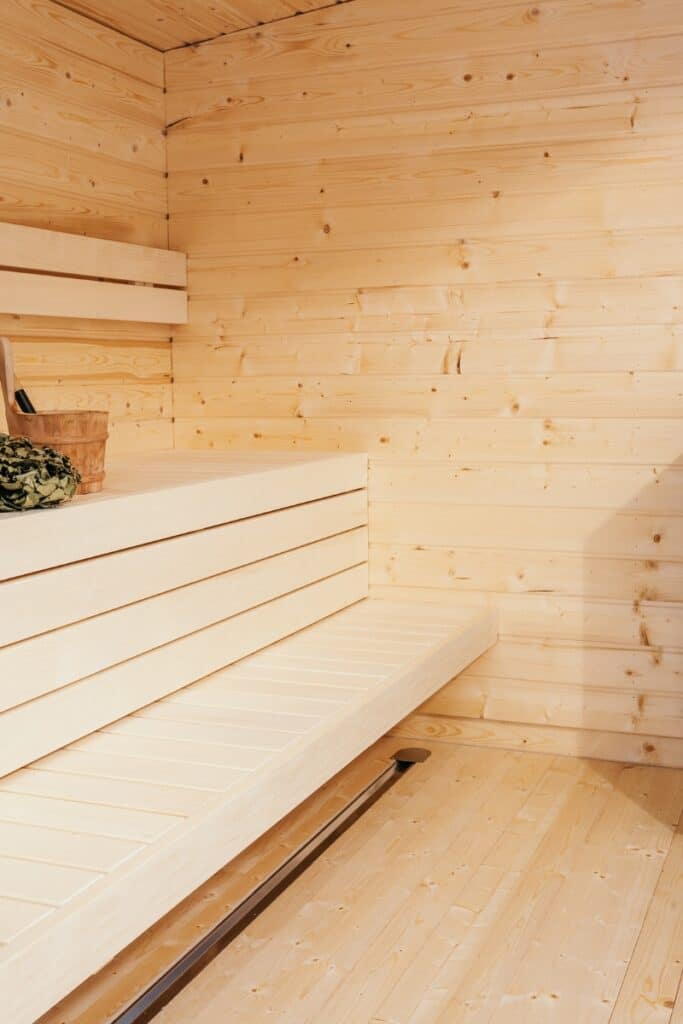
3. Material
Look for saunas constructed from high-quality materials like cedar, hemlock, or pine. These woods are durable and resistant to moisture, ensuring the sauna’s longevity.
What to Consider:
- Cedar: Cedar saunas are popular due to their natural resistance to moisture and pests. They also emit a pleasant aroma when heated.
- Hemlock: Hemlock is another moisture-resistant wood often used in sauna construction.
- Pine: Pine saunas are more budget-friendly but may require more maintenance.
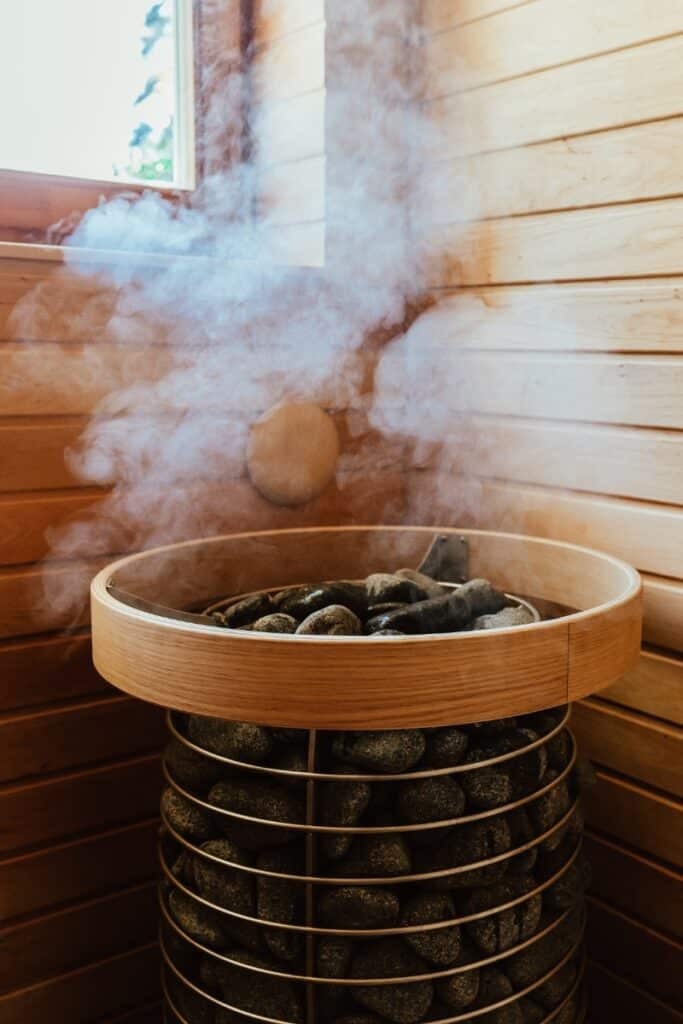
4. Heating System
Consider the type of heating system the sauna employs. Traditional saunas typically use wood-burning or electric heaters, while infrared saunas use infrared panels. Ensure the heating system aligns with your desired sauna experience.
What to Consider:
- Traditional Heaters: Traditional saunas use wood-burning stoves or electric heaters with sauna rocks. These provide intense, dry heat and allow you to create bursts of steam by pouring water over the rocks.
- Infrared Panels: Infrared saunas use infrared panels to emit radiant heat, heating your body directly. They operate at lower temperatures and provide a gentle, penetrating heat.
- Steam Generators: Steam saunas rely on a steam generator to produce humidity and warmth. These are ideal for a soothing, moist sauna experience.

5. Temperature Range
Check the sauna’s temperature range and ensure it matches your preferences. Traditional Finnish saunas reach higher temperatures, while infrared saunas operate at lower, more gentle heat levels.
What to Consider:
- Finnish Saunas: Finnish saunas can reach higher temperatures (160°F to 195°F).
- Infrared Saunas: Infrared saunas operate at lower temperatures (120°F to 140°F).
- Steam Saunas: Steam saunas typically fall in between (110°F to 115°F).

6. Additional Features
Many saunas come with extra features such as built-in sound systems, chromotherapy lighting, and ergonomic seating. Choose the features that enhance your sauna experience.
What to Consider:
- Sound Systems: Built-in sound systems or Bluetooth connectivity allow you to enjoy music or relaxation sounds during your sauna sessions.
- Chromotherapy Lighting: Colored LED lights can create a calming ambiance.
- Ergonomic Seating: Comfortable and well-designed seating can greatly enhance your sauna experience.
- Control Panels: User-friendly control panels allow you to adjust temperature, humidity, and other settings with ease.
- Aromatherapy: Some saunas offer the option to incorporate essential oils for aromatherapy benefits.

6. Safety Features
Ensure that the sauna you choose complies with safety standards and has features like overheat protection and proper ventilation.
What to Consider:
- Overheat Protection: A built-in safety feature that prevents the sauna from overheating.
- Ventilation: Proper ventilation ensures fresh air circulation and prevents excess humidity buildup.
- Certifications: Ensure the sauna complies with safety standards and certifications, especially for electrical components.
- EMF Levels: Saunas, especially those that use electrical components, can emit EMFs (Electromagnetic Field). You can check with the manufacturer to verify that EMF levels are in compliance.
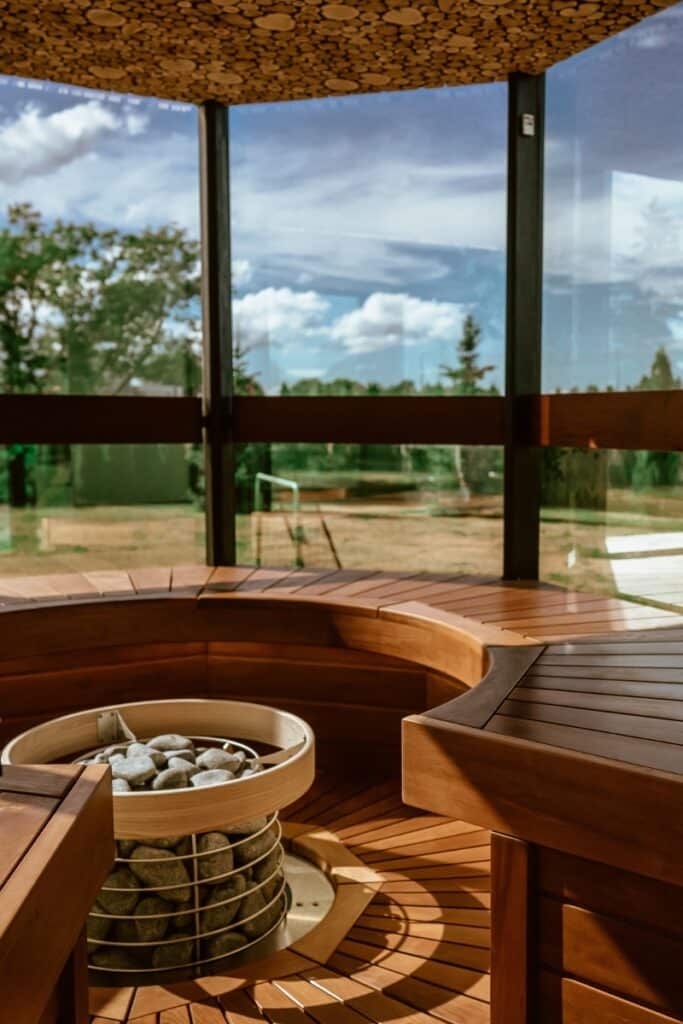
8. Power Requirements
Often overlooked, It’s important to consider the power usage your sauna will require. Some saunas operate on a standard 120V, 15-amp circuit, which can be conveniently plugged into any typical household outlet. On the other end of the spectrum, larger units may require as much as 240V, drawing 30 amps.
What to consider:
- Steam & Electric: Both steam saunas and electric dry saunas typically rely on a 20-30 amp 220V power supply.
- Infrared: Many infrared saunas are designed to function efficiently with a 15-amp, 110V setup, making them an attractive option for many users. Not needing to upgrade your electrical system is often a significant selling point, depending on your specific needs and preferences.
Many people wonder whether the lower electrical requirements of infrared saunas affect their performance. In fact, quite the opposite is often true. Infrared saunas tend to heat up faster and require shorter preheat time.
9. Warranty
A good warranty provides peace of mind. Look for saunas backed by a comprehensive warranty that covers both the sauna’s construction and heating elements.
10. Budget & Pricepoint
Your budget range will impact the size of your sauna as well as the amount of special features. Determine the minimum size for your sauna and must-have features before committing to a budget range. This will ensure you purchase a sauna that complements your lifestyle and will stand the test of time.
Final Thoughts
Saunas offer an array of health benefits that are supported by scientific research. From stress reduction and detoxification to cardiovascular improvements and pain relief, regular sauna use can be a valuable addition to your wellness routine. When choosing a sauna, carefully assess your preferences, needs, and available space to find the perfect fit for your home. Whether you opt for a traditional Finnish sauna, an infrared sauna, or a steam sauna, you can look forward to a wealth of physical and mental health benefits that have been cherished for generations.





